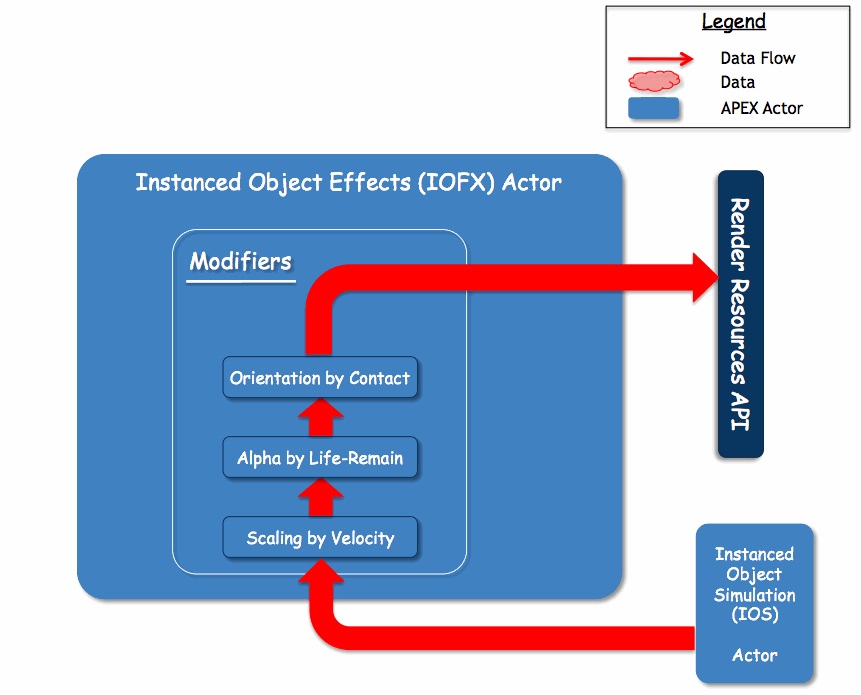APEX Particles Module Programmers Guide Introduction¶
Introduction¶
The APEX Particles module is a particle (object) pipeline that is designed to produce a wide range of scalable effects in games. Each stage of the pipeline is an APEX actor derived from an APEX asset whose parameters are authored. The particle pipelines consists of a particle emitter, an Instanced Object Simulation (IOS) that computes the physical movement and life remaining of each particle, and an Instanced Object Effects (IOFX) actor that based on the particles physical characteristics determines how the particles (objects) in the pipeline are rendered. A game level editor can create multiple emitter actors in a game level. They can be of the same type or of different types. The emitter actors can reference any number of IOS or IOFX actors. The IOS and IOFX actors are created automatically by APEX.

APEX Particle Pipeline
APEX particle emitter actors emit particles at the start of the particle pipeline. Presently there are three basic types of Emitter Authorable Objects. They are the Simple Shape Emitter, Air / Ground Emitter, and the Weapon Impact Emitter. The current shape emitters are the box emitter, the sphere emitter, the sphere shell emitter, and the explicit emitter. The box and sphere emitters emit particles (objects) in their shape. The sphere shell emitter emits particles within the shell of a specified thickness around a sphere. Finally the explicit emitter outputs particles at explicit user defined locations. The parameters that control the behavior of each of these emitters is documented here:
Presently two IOSes have been implemented. They are the BasicIos and the PxParticleIos (Particles Library). The BasicIos provides parameters that control the basics of a stream of particles, such as the resting density, the particle radius and the maximum number of particles. The BasicIos does not interact with PhysX SDK force fields. PxParticleIos is a wrapper for PhysX particle simulation.
There are multiple IOFX modifiers that each provide unique capabilities. Multiple IOFX modifiers can be used by a particle pipeline. Within the IOFX library the modifiers act as elements in the particle pipeline passing the output of one modifier to the input of the next. The following diagram illustrates the internal IOFX pipeline.

APEX IOFX Pipeline
The IOFX Asset Parameters are documented here:
- APEX IOFX Asset Parameters
- APEX Mesh IOFX Continuous Modifier Parameters
- APEX Sprite IOFX Continuous Modifier Parameters
- APEX Mesh IOFX Spawn Modifier Parameters
- APEX Sprite IOFX Spawn Modifier Parameters
All of the currently implemented modifiers are data driven (as opposed to procedural). In the long term, it will be possible to implement a procedural modifier that will allow game developers to write their own modifier subroutines (similar to GPU shader programs). Modifiers will be initially implemented on the CPU, however, the architecture supports an alternative CUDA version for use when running on CUDA enabled GPU’s. On CUDA enabled systems, particle data will be able to be passed from CUDA compatible IOS’es to CUDA compatible IOFX Modifiers while remaining entirely in GPU memory. When support for CUDA/DirectX Interoperability is enabled, data will be able to be passed from CUDA IOFX Modifiers to the game’s rendering engine (through the Render Resources API), while remaining entirely in GPU memory.
Performance Considerations¶
Particle system run-time performance is primarily linear with the resource budget given to the IOS modules. However, the largest source of overhead is in the number of active fluid simulations. To achieve optimal performance for a given particle budget, you should use the fewest number of IOS actors as possible. The number of emitters and IOFX assets that share an IOS have a relatively small effect on performance.
To limit the number of IOS actors, one can simply limit the number of IOS assets. Also be aware that an IOS actor must operate as either a mesh simulation or a sprite simulation, so if two emitters use an IOS asset with both sprite and mesh IOFX assets, APEX will generate two IOS actors - one for each simulation type.
Per-IOS Actor Resources:
- particle simulation buffers
- IOFX modifier state buffers
- CUDA IOFX modifiers are batched to run on an entire IOS at once
- double or triple instanced output buffers
- single sprite or instance render resource
- one writeBuffer() call per simulation step, when interop is not used
Per-IOFX Actor Resources:
- one UserRenderResource holding a particle range in its IOS sprite/instance buffer
- one dispatch (draw call) per render frame
- CPU IOFX modifiers run in parallel in the APEX thread pool
Per-Emitter Actor Resources:
- Computation time to emit particles
- Storage for particles until they are injected into the simulation
PhysX SDK Compatibility¶
APEX Particles is compatible with all PhysX SDKs that support APEX.